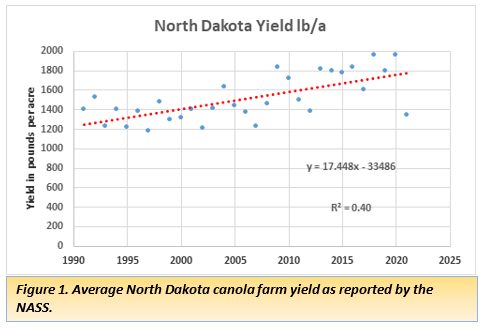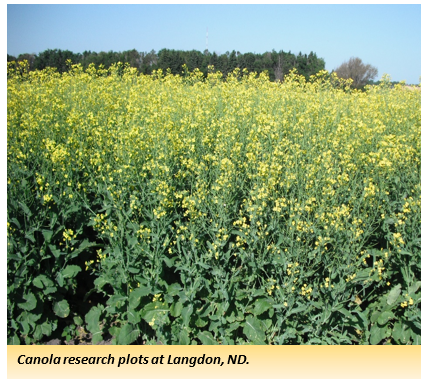Canola (05/12/22)
The average North Dakota canola yield for the last ten growing seasons was 1,728 pounds per acre. Based on the March National Agricultural Statistics Service report, North Dakota producers are planning to seed close to 1.76 million canola acres. On average the annual canola yield increase, from 1990 to 2021, has been 17.5 pounds per acre per year (Figure 1). This increase is due to better genetics and management. The yield for each individual year varies based on the environmental conditions. Late planting or limited available moisture during the growing season may reduce the yield potential. For instance, drought reduced yield in 2021 (Figure 1).

Based on the trend line, the average North Dakota farm yield for 2022 is estimated at 1,794 pounds per acre. If planting in 2022 will be delayed, the yield could be lower.
Some key management suggestions for getting high canola yields:
- Plant canola hybrid that have shown high yield potential in University and company trials. These trials should be at several locations in your respective growing region.
- Field selection is critical to obtain high yields. Canola best follows cereal grains in a rotation. Avoid crops such as sunflower, dry beans, and soybean in close rotation with canola, as all these crops are susceptible to white mold (Sclerotinia). Also select fields that are free of troublesome weed problems.
- Plant seed that has a high germination percent with high seedling vigor. Planting seed treated with both an insecticide and fungicides for seedling protection is recommended.
- Plant canola into a firm seedbed and at a uniform depth. Seeding depths recommended are ¾ to 1 inch. A stand of 6 to 8 established plants per square foot is a good target to get optimum yields, with row spacings narrower than 12 inches. A minimum stand of 3-4 plants per square foot just will not provide the higher potential yields that can be obtained with higher plant populations.
- Canola is a crop that responds well to fertilizer applied. Both nitrogen and sulfur are the key nutrients for high yields. Use recommended fertilizer rates.
- Control weeds early if possible since a lot of weed competition early in the season can reduce yields very quickly.
- Monitor for any flea beetle pressure and other pest problems early in the growth and development stages of canola (especially during the first three weeks after emergence). Be prepared to apply an insecticide if the seed treatment does not hold long enough or the insect pressure is too great.
- As canola gets near the bud stage or early bloom, start monitoring the NDSU Canola Disease Risk map site for Sclerotinia stem rot (white mold) potential. Have a plan to get the correct fungicide applied should the risk be high.
- For additional production information see the Canola production publication

Extension Agronomist Broadleaf Crops
